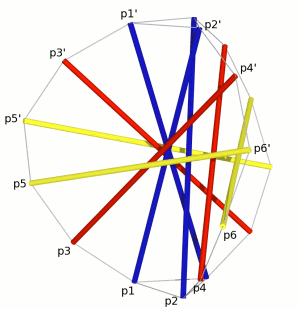
Three-fold Fan Prism (Two-Strut Girdle) with Point Labels
Member Descriptions
[name, end point names, weight (if in objective function),
second power of length (if a constraint), member category,
Obj/Con/Exc (put in objective function, use as a constraint or
exclude from computations), flags]
For assembly purposes, only the name and end point names are
of interest. The other information may be of interest after
A Practical Guide to Tensegrity Design has been consulted.
# struts
<Member> strut1 p2' p1 -1.08483 sqr(2.5) 1 Obj CalcClear *
<Member> strut2 p4' p3 -1.0 sqr(2.5) 1 Obj CalcClear *
<Member> strut3 p6' p5 -1.40225 sqr(2.5) 1 Obj CalcClear *
# side tendon
<Member> side1 p3' p1' 3.0 sqr(0.5) 3 Con *
<Member> side1a p3' p5' 3.0 sqr(0.5) 3 Con *
<Member> side2 p5 p5' 3.0 sqr(0.5) 3 Con *
<Member> side3 p5 p3 3.0 sqr(0.5) 3 Con *
<Member> side3a p1 p3 3.0 sqr(0.5) 3 Con *
# bottom tendon
<Member> end1 p2 p1 1.0 sqr(0.5) 2 Con *
# top tendon
<Member> end2 p2' p1' 1.0 sqr(0.5) 4 Con *
In-Situ Member Lengths
These are the lengths of the members when they are in place
and prestress is applied. The strut lengths are from
screw-eye center to screw-eye center, as are the tendon lengths.
These values are in model units.
strut1: 1.87018 strut2: 1.87018 strut3: 1.87019
side1: 0.5 side1a: 0.5 side2: 0.5
side3: 0.5 side3a: 0.5 end1: 0.5
end2: 0.5
Relative Member Prestress Force Magnitudes
These values are useful for developing an assembly
strategy for the structure. The tighter tendons are much
easier to tie in place early on, while the looser tendons
can be left to the last. This information is also used
to adjust tendon lengths since the measured length of a tendon
will be shorter for a highly-stressed tendon with the same
in-situ length as a tendon which is not so stressed.
strut1: -2.02883 strut2: -1.87018 strut3: -2.62247
side1: 3.91592 side1a: 3.91591 side2: 4.16017
side3: 3.91591 side3a: 3.91592 end1: 2.28445
end2: 2.28445
Average tendon force magnitude: 3.48468
Construction Lengths (in millimeters and halves)
The construction length of a tendon is less than the in-situ
length since when the tendon is measured off it isn't under
any prestress force. The construction length for the strut
represents the length of the 5/16-inch-diameter wooden dowel.
Braided nylon fishing line was used for the tendons.
Prestress forces are assumed to affect tendon lengths and
not strut lengths.
Elongation of Tendon of Unit Cross Section
Under Force of Average Magnitude (fraction)> 0.02
Length Scale Factor> 209.5/1.87018
Strut and Tendon Hub Adjustments - s;t> 4.75; 3.0
(The 4.75 mm adjustment for the strut is the amount
the screw-eye center extends from the dowel. The 3.0 mm
adjustment for the tendon is half the outer diameter of the
screw eye.)
strut1: 200 0 strut2: 200 0 strut3: 200 0 side1: 49 0
side1a: 49 0 side2: 49 0 side3: 49 0 side3a: 49 0
end1: 49 1 end2: 49 1

Three-fold Fan Prism (Two-Strut Girdle) with Point Labels
structure file: tprism/x3girdle1b.rc variable file: tprism/x3girdle1b.dat digit list: src/mm.dls |
|
CONTACT: Bob Burkhardt Tensegrity Solutions Box 426164 Cambridge, MA 02142-0021 USA e-mail: bobwb@juno.com |
Back to Marcelo Pars' “drie waaiers” (three fans)
More Datasheets